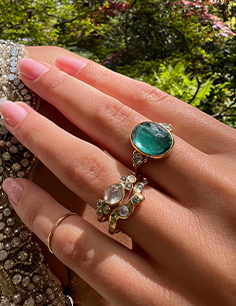Everything You Need to Know About Moonstone Jewelry

Rainbow Moonstone jewelry has captivated beholders for centuries. Each beautiful moonstone has its own unique shine and colors, and its physical composition has been compared to the moon's reflection on a water's surface.
Like our other favorite feldspars, labradorite and sunstone, Moonstone has a unique vibrant natural optical effect called adularescence. The effect can look like light shimmering below the surface of the stone, similar to the moon on a cloudless evening.
As each moonstone is unique, genuine moonstone jewelry offers a variety of shades and colors. They are commonly cut into domed cabochon shapes, we tend to use faceted stones, similar to diamonds.
What Are Moonstones?
Moonstones are a mineral composed of silicate and potassium aluminum, and they are one of the only gemstones where adularescence can occur. Moonstones have distinguished looks that set them apart from other gemstones with various colors, shapes, clarity, and sizes.
Moonstones are a more fragile gemstone and have a Mohs Hardness Scale rating between 6 and 6.5. This fragility allows moonstones to be cut and shaped uniquely for many types of moonstone fine jewelry.
However, they are commonly used for necklaces and earrings instead of rings to avoid breakage because of their fragility. In addition, when crafted into rings, moonstones are commonly set deep within a harder gemstone to provide added protection against damage.
The History and Lore of Moonstone Jewelry
Moonstone jewelry has a rich history that began in ancient Rome. The stone's name was given by a Roman naturalist who believed that the quality of the gemstone changed in tandem with the phases of the moon. Additionally, moonstones were associated with the Goddess of the Moon in both Greek and Roman mythologies.
Similarly, it was believed that moonstones were composed of solidified moonbeams in Hindu mythology. Moonstone jewelry became a symbol of good luck, and old legends said that you could see the future during a full moon if you held a moonstone in your mouth. Additionally, moonstones were often associated with protection and healing throughout history.
In modern society, fine moonstone jewelry became popular in the early 1990s during the Arts and Crafts and Art Nouveau movements. The "flower child" movement in the 1960s furthered the popularity of the gem when flower children wore moonstone jewelry as part of their aesthetic for an ethereal look.
Today, moonstones are mined worldwide, including in the United States, India, Australia, Brazil, Madagascar, and Myanmar, but the most sought-after moonstones are mined in Sri Lanka.
Genuine Moonstone Jewelry Quality and Cost Factors
The value of moonstone jewelry is determined by several factors, including its color, clarity, cut, and carat weight. The highly desirable rainbow moonstone is the most coveted. Gem lovers love the flash that a glowing, colorful rainbow moonstone can provide.
These varying factors play an essential role in the gemstone's beauty, value, and demand. Here's a closer look at each of these dominant factors:
-
Color: While moonstones can have various colors, the most valuable moonstones are colorless and as transparent as possible with a vivid blue adularescence. This highly desirable form of adularescence is commonly referred to as a "blue sheen." Moonstones with a blue sheen are valuable even if they are not entirely transparent.
-
Clarity: The clearer the moonstone, the higher the moonstone's quality and value become. Moonstones that are not transparent can appear milky and contain inclusions that may interfere with the adularescence of the moonstone, thus reducing their value. Moonstones that have small tension cracks are also considered less valuable.
-
Cut: Moonstones can be cut in many different ways. However, the best moonstone jewelry displays the cabochon cutting style. This style is used to display the moonstone's best features, including its adularescence.
However, very flat cabochons are far less valuable, as flat moonstones generally do not show the same quality of adularescence sheen. In recent years, faceted moonstones have also grown in popularity as this type of cut is commonly used to hide any present inclusions.
- Carat Weight: Like many gemstones, moonstone jewelry comes in various sizes and carat weight. However, it becomes more challenging to find genuine moonstone jewelry in larger sizes.
Caring for Your Moonstone Jewelry
You must know how to care for your moonstone fine jewelry to preserve its beauty, quality, and value. While the two most popular jewelry cleaning methods are steam and ultrasonic cleaning, neither of these methods is safe to use on moonstones because moonstones can be damaged by heat.
However, moonstone jewelry can be cleaned in a simple way. You can use a non-acidic jewelry cleaner or warm water with a few drops of dish detergent to clean your moonstones gently.
After, let your jewelry dry before buffing it lightly with a soft cloth. You should always check and ensure that your moonstone is secure in your jewelry before wearing it again.
Where to Find the Right Moonstone Fine Jewelry
Moonstone fine jewelry comes in various colors and shapes to display its unique beauty. Because each moonstone is unique, it’s essential to take your time in selecting which rainbow moonstone speaks directly to you.
Are you looking for genuine moonstone jewelry? Then, view our one-of-a-kind collection to find the perfect moonstone jewelry for you.









